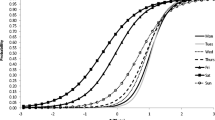Abstract
The major purposes of the study were: a) to examine the relationship between attitudes and self-reported levels of drinking; and b) to develop a stable prediction equation that included attitudes as a predictor of drinking behavior. A Likert-type survey was developed to measure college student's attitudes toward alcohol. The survey was administered to a sample of college students (n=1049). The coefficient alpha reliability estimate was found to be .91. Stepwise multiple regression procedures were used to ascertain the relationships between attitudes and other psychosocial constructs of drinking. The dependent variable was an alcohol consumption index. The analysis revealed that the seven variable model was the most parsimonious (R2=.46), and attitudes toward drinking was the strongest predictor of self-reported drinking behavior. A double cross-validation of the regression model indicated that the model was very stable, and therefore could be generalized to similar samples. The substantive findings related to students' self-reported drinking practices are also reported.
Similar content being viewed by others
References
Bangert-Drowns, R. L. (1988). The effects of school-based substance abuse education — a meta-analysis.Journal of Drug Education, 18(3), 243–264.
Botvin, G. J. (1986). Substance abuse prevention research: Recent developments and future directions.Journal of School Health, 56(9), 369–374.
Cahalan, D. (1991).An ounce of prevention. San Francisco: Josey-Bass Publishers.
Duncan, D. & Gold, R. (1985).Drugs and the whole person. New York; Macmillan.
Dancer, L. S. (1990). Introduction to facet theory and its applications.Applied psychology: An international review, 39(4): 365–377.
Edmundson, E. W., Koch, W. R., & Silverman, S. J. (1993). A facet analysis approach to content and construct validity.Educational and Psychological Measurement., 53 351–368.
Eiser, C., Eiser, J. R., Claxton-Oldfield, S., & Pritchard, M. (1988). Attitudes, attributions, and persuasion: How young people's ideas about drugs relate to their preferences for different strategies of prevention.Journal of Substance Abuse, 1 35–44.
Fishbein, M. & Azjen, I. (1975).Belief, attitude, intention and behavior: An introduction to theory and research. Reading, Mass.: Addison-Wesley.
Goodstadt, M. & Caleekal-John, A. (1984). Alcohol education programs for university students: A review of their effectiveness.The International Journal of the Addictions, 19(7), 721–741.
Goodstadt, M., Cook, G., Magid, S., & Gruson, V. (1978). The Drug Attitude Scale (DAS): Its development and evaluation.The International Journal of the Addictions, 13(8), 1307–1317.
Guttman, L. (1954). An outline of some new methodology for social research.Public Opinion Quarterly, 18 395–404.
Guttman, L. (1981). What is not what in theory construction. In I. Borg (Ed.),Multidimensional data representations: When and why (pp. 47–64). Ann Arbor, MI: Mathesis Press.
Hansen, W. B. (1992). School-based substance abuse prevention: A review of the state of art in curriculum, 1980–1990.Health Education Research, 7(3), 403–430.
Hansen, W. B., Graham, J. W., Wolkenstein, B. H., Lundy, B. Z., Pearson, J., Flay, B. R., & Johnson, C. A. (1988). Differential impact of three alcohol prevention curricula on hypothesized mediating variables.Journal of Drug Education, 18(2), 143–153.
Hennessy, M. (1991). Designing and evaluating alcohol problem community interventions: Quasi-lessons from the experience of medical trials.Journal of Primary Prevention, 11(3), 169–192.
Johnston, L. D., O'Malley, P. M., & Bachman, J. G. (1991).Drug use among American high school seniors, college students and young adults, 1975–1990. (DHHS Publication No. ADM 91-1835). Rockville, MD: National Institute on Drug Abuse.
Levy, S. (1981). Lawful role of facets in social theories. In I. Borg (Ed.),Multidimensional data representations: When and why (pp. 65–107). Ann Arbor, MI: Mathesis Press.
Levy, S. (1982).Use of drug and medication in Israel (Institute Monograph No. 865). Jerusalem: The Israel Institute of Applied Social Research.
McCarty, D., Morrison, S., & Mills, K. (1983). Attitudes, beliefs and alcohol use: An analysis of relationships.Journal of Studies on Alcohol, 44(2), 328–341.
Massachusetts Medical Society. (1990). Alcohol-related mortality and years of potential life lost 1987-United States, 1990.Morbidity and Mortality Weekly Report, 39(11), 174–178.
Meichenbaum, D. (1977)).Cognitive Behavior Modification. New York: Plenum.
Moskowitz, J. M. (1983). Preventing adolescent substance abuse through drug education.National Institute on Drug Abuse Research Monograph Series, 47: 233–249.
Moskowitz, J. M. (1989). The Primary prevention of alcohol problems: A Critical review of the research literature.Journal of Studies on Alcohol, 50(1), 54–88.
National Institute on Drug Abuse (1987).National trends in drug use and related factors among American high school students and young adults, 1975–1986. (DHHS Publication No. ADM 87-1535). Washington, DC: US Government Printing Office.
National Institute on Drug Abuse. (1986).Drug Use Among American High School Students, College Students, and Other Young Adults. (DHHS Publication No. 81-1450). Washington D.C.: U.S. Government Printing Office.
Rundall, T. G., & Bruvold, W. H. (1988). A Meta-analysis of school-based smoking and alcohol use prevention programs.Health Education Quarterly, 15(3), 317–334.
Swadi, H. & Zeitlin, H. (1987). Drug education to school children: Does it really work?British Journal of the Addictions, 82 741–746.
Torabi, M. R. & Veenker, C. H. (1986). An alcohol attitude scale for teenagers.Journal of School Health, 56(3), 96–100.
U.S. Department of Health, Education and Welfare (1979).Healthy People: The Surgeon General's Report on Health, Promotion and Disease Prevention (DHEW Publication No. ADM 79-55071). Washington D.C.: U.S. Government Printing Office.
U.S. Department of Health and Human Services (January, 1987).Sixth Special Report to the U.S. Congress on Alcohol and Health. (DHHS Publication No. ADM 87-1519). Washington D.C.: U.S. Government Printing Office.
Author information
Authors and Affiliations
Rights and permissions
About this article
Cite this article
Edmundson, E.W., Clifford, P., Serrins, D.S. et al. The development of a model to predict drinking behavior from attitudes in university students. J Primary Prevent 14, 243–277 (1994). https://doi.org/10.1007/BF01324449
Issue Date:
DOI: https://doi.org/10.1007/BF01324449




